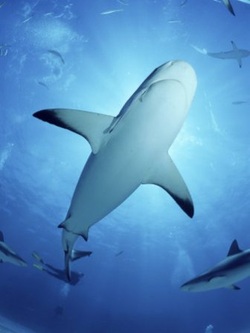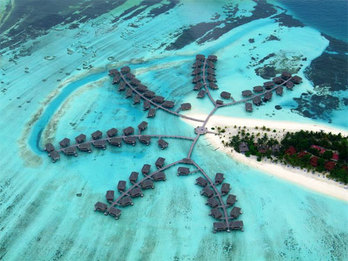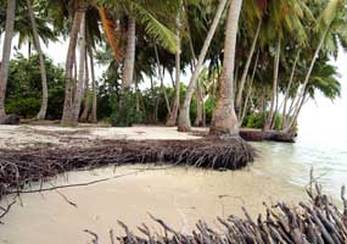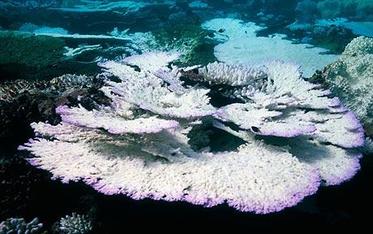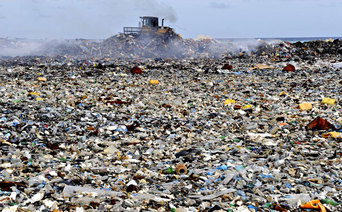Impacts of the Tourism Industry on the Environment
Positive Impacts:
Tourism in the Maldives appears to be very detrimental to the environment, however if it is done correctly tourism can be beneficial. For example: Fishing is also one of the biggest providers of foreign currency to the Maldives economy but because tourists pay to come see the fish that the fishermen (and women) are catching the two are competing against each other. Fishing can be harmful to the environment if too many fish are caught and fish are not given time to replenish and it is also harmful to the tourism industry if there are no fish left for the tourists to come and look at. However the tourism can be beneficial to the environment if resort owners employ the fishermen to come and take tourists to see the fish instead of catching them and also pay the fishermen more. They are then benefiting the environment, (less fish are caught), tourism, (more tourists come to see the fish), and the society and economy (the workers are paid more and there are more tourists.)
Tourism in the Maldives appears to be very detrimental to the environment, however if it is done correctly tourism can be beneficial. For example: Fishing is also one of the biggest providers of foreign currency to the Maldives economy but because tourists pay to come see the fish that the fishermen (and women) are catching the two are competing against each other. Fishing can be harmful to the environment if too many fish are caught and fish are not given time to replenish and it is also harmful to the tourism industry if there are no fish left for the tourists to come and look at. However the tourism can be beneficial to the environment if resort owners employ the fishermen to come and take tourists to see the fish instead of catching them and also pay the fishermen more. They are then benefiting the environment, (less fish are caught), tourism, (more tourists come to see the fish), and the society and economy (the workers are paid more and there are more tourists.)
Negative Impacts
Tourism in the Maldives has many, serious negative effects on the
environment.
For the atolls to be available for resort use they have to be easy and safe access and berthing for boats coming into the resort. Therefore each coral reef has to be blasted to allow a channel through to the lagoon. The inner lagoon is then dredged to allow for the draught of the tourist boats. This causes coral to die as the excess sediment is deposited on top of it, killing it. The disruption of the sea bed causes a decline in water quality and visibility effecting coral health as well. This also causes a disruption in the marine ecosystems and currents which can be very harmful.
Because islands can only have 20% built up to preserve the island resort owners build out into the lagoon. The jetties that service the resort rooms are generally made of solid rock and are very detrimental to the health of the island and surrounding lagoon. Before the jetties were built the natural currents circled the island circulating the sand around the island evenly. However these solid jetties are not allowing that to happen so sand is piling up along the edge of the jetty and not making it around to the other side of the island. This is causing erosion on the other side of the island as the waves that were normally breaking on the sand are now breaking straight onto the island itself. It has also affected the habitats of marine and animal life around the island, as their homes have been destroyed by the unnatural moving of the sand.
The tourism in the Maldives is based on the sea and many boats go out into the reef each day for tourist activities. Since the sea bed is made of coral reef each time they drop anchor they are latching onto coral and breaking it off, killing it. Coral is a very fragile plant and takes years to grow. Coral grows between only 5mm to 20cm a year. A study found that a cruise ship anchoring in a coral reef for one day destroys an area half the size of a football field completely destroyed and half that size again died later. Coral recovery was estimated to take 50 years.
Tree roots provide an important anchor for any land area as the roots spread through large areas of soil and hold it together, stopping it getting eroded, washed or blown away. This is especially important in the Maldives where the islands are made of fine particles of sand, coral and sediment and if very vulnerable. So when coastal vegetation is removed for tourist facilities it severely damages the natural environment.
Because of the large amount of human contact with the land sewage and other liquid waste is in abundance and is disposed on the island. They then seep into the lagoon which then leads to contamination of the lagoon causing death of coral and increase the amount of sea grasses and algae which are not necessarily wanted.
Rubbish is the most serious negative effect on the environment in the Maldives. With about 70,000 tourists visiting the Maldives each year a significant amount of rubbish is produced. In the 90’s the Maldivian authorities turned an atoll named Thilafushi into a rubbish dump (rubbish island) because of the increasing amount of rubbish from tourists that they couldn’t cope with. Thilafushi used to be seven kilometers by 200 meters but is now growing by a square meter every day. Rubbish is shipped daily from the resort islands. In the beginning pits were dug but the volumes of rubbish became too big to cover up with sand, so it is now in piles covering the island. The lagoon surrounding the island will also eventually be filled with rubbish. The rubbish on the island also contains many deadly chemicals such as the toxic heavy metals mercury, lead, cadmium and also asbestos. Because of global warming the islands in the Maldives are at serious risk of the rising sea levels because they are only 1m above sea level. This will be a major health and environmental risk as the toxic chemicals are already capable, and are, leeching in to the sea and this will be very harmful to the ecology surrounding the island. This will also affect human health because of the number of Maldivian locals who rely on the ocean for their food supply and this will be contaminated.
For the atolls to be available for resort use they have to be easy and safe access and berthing for boats coming into the resort. Therefore each coral reef has to be blasted to allow a channel through to the lagoon. The inner lagoon is then dredged to allow for the draught of the tourist boats. This causes coral to die as the excess sediment is deposited on top of it, killing it. The disruption of the sea bed causes a decline in water quality and visibility effecting coral health as well. This also causes a disruption in the marine ecosystems and currents which can be very harmful.
Because islands can only have 20% built up to preserve the island resort owners build out into the lagoon. The jetties that service the resort rooms are generally made of solid rock and are very detrimental to the health of the island and surrounding lagoon. Before the jetties were built the natural currents circled the island circulating the sand around the island evenly. However these solid jetties are not allowing that to happen so sand is piling up along the edge of the jetty and not making it around to the other side of the island. This is causing erosion on the other side of the island as the waves that were normally breaking on the sand are now breaking straight onto the island itself. It has also affected the habitats of marine and animal life around the island, as their homes have been destroyed by the unnatural moving of the sand.
The tourism in the Maldives is based on the sea and many boats go out into the reef each day for tourist activities. Since the sea bed is made of coral reef each time they drop anchor they are latching onto coral and breaking it off, killing it. Coral is a very fragile plant and takes years to grow. Coral grows between only 5mm to 20cm a year. A study found that a cruise ship anchoring in a coral reef for one day destroys an area half the size of a football field completely destroyed and half that size again died later. Coral recovery was estimated to take 50 years.
Tree roots provide an important anchor for any land area as the roots spread through large areas of soil and hold it together, stopping it getting eroded, washed or blown away. This is especially important in the Maldives where the islands are made of fine particles of sand, coral and sediment and if very vulnerable. So when coastal vegetation is removed for tourist facilities it severely damages the natural environment.
Because of the large amount of human contact with the land sewage and other liquid waste is in abundance and is disposed on the island. They then seep into the lagoon which then leads to contamination of the lagoon causing death of coral and increase the amount of sea grasses and algae which are not necessarily wanted.
Rubbish is the most serious negative effect on the environment in the Maldives. With about 70,000 tourists visiting the Maldives each year a significant amount of rubbish is produced. In the 90’s the Maldivian authorities turned an atoll named Thilafushi into a rubbish dump (rubbish island) because of the increasing amount of rubbish from tourists that they couldn’t cope with. Thilafushi used to be seven kilometers by 200 meters but is now growing by a square meter every day. Rubbish is shipped daily from the resort islands. In the beginning pits were dug but the volumes of rubbish became too big to cover up with sand, so it is now in piles covering the island. The lagoon surrounding the island will also eventually be filled with rubbish. The rubbish on the island also contains many deadly chemicals such as the toxic heavy metals mercury, lead, cadmium and also asbestos. Because of global warming the islands in the Maldives are at serious risk of the rising sea levels because they are only 1m above sea level. This will be a major health and environmental risk as the toxic chemicals are already capable, and are, leeching in to the sea and this will be very harmful to the ecology surrounding the island. This will also affect human health because of the number of Maldivian locals who rely on the ocean for their food supply and this will be contaminated.
The effects of coral blasting can be clearly seen in the above photo where a channel has been formed to allow boats access to the jetties.
Erosion caused by the disruption of natural currents and patterns due to resort jetties.
The effects of tourism on coral reefs.
Thilafushi - the Maldives rubbish island.
